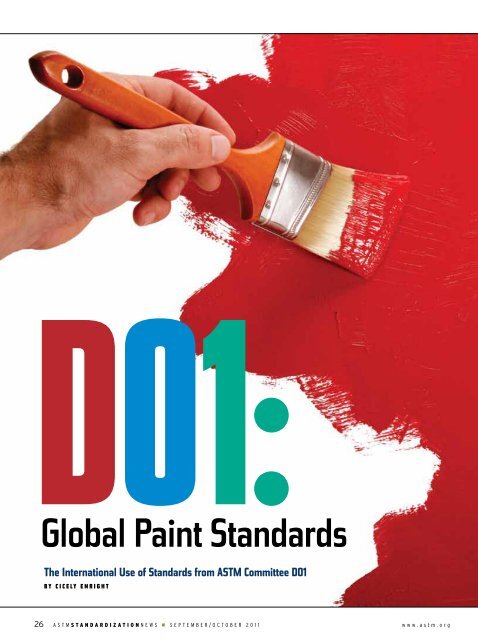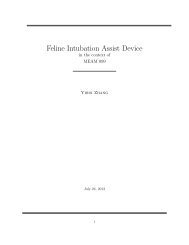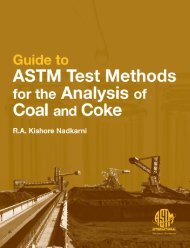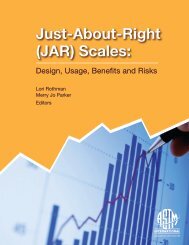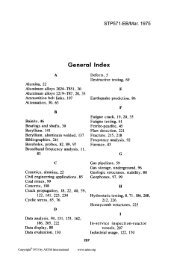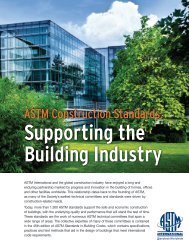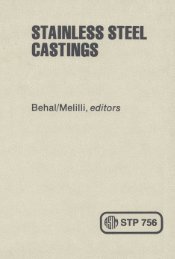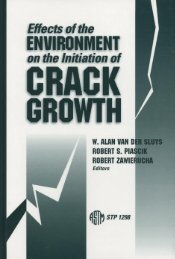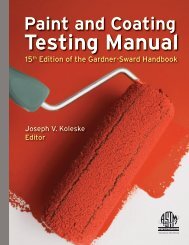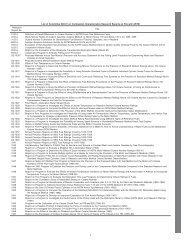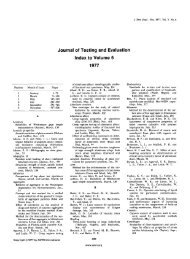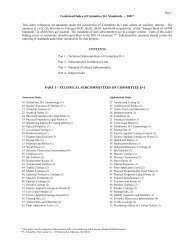D01:Global Paint Standards - ASTM International
D01:Global Paint Standards - ASTM International
D01:Global Paint Standards - ASTM International
Create successful ePaper yourself
Turn your PDF publications into a flip-book with our unique Google optimized e-Paper software.
<strong>D01</strong>:<br />
<strong>Global</strong> <strong>Paint</strong> <strong>Standards</strong><br />
The <strong>International</strong> Use of <strong>Standards</strong> from <strong>ASTM</strong> Committee <strong>D01</strong><br />
B y C i C e ly e n r i g h t<br />
26 a s t m S T A N D A R D I Z A T I O N N e w s o s e p t e m b e r / O c t O b e r 2 0 1 1 w w w . a s t m . o r g
This is an authorized reprint from <strong>ASTM</strong> Standardization News,<br />
Volume 39, Number 5, September/October 2011 (© Copyright 2011<br />
<strong>ASTM</strong> <strong>International</strong>, 100 Barr Harbor Drive, P.O. Box C700, West<br />
Conshohocken, PA 19428-2959) for personal use only. It may not be<br />
copied, uploaded to the Internet or any internal computer network<br />
without written permission. For permission or more information,<br />
contact mgorman@astm.org.<br />
<strong>Paint</strong> and coatings color our<br />
world, and ensuring their<br />
quality as well as that of<br />
varnish, lacquer, printing ink<br />
and artists’ materials are the standards<br />
developed by a longstanding <strong>ASTM</strong><br />
<strong>International</strong> committee.<br />
The more than 600 members of<br />
Committee <strong>D01</strong> on <strong>Paint</strong> and Related<br />
Coatings, Materials and Applications,<br />
which traces its roots to the early<br />
years of <strong>ASTM</strong> <strong>International</strong>, include<br />
representatives from 36 countries who<br />
oversee more than 650 standards.<br />
<strong>Global</strong>ization has changed the face<br />
of business in many ways, and one<br />
result is that <strong>ASTM</strong> <strong>D01</strong> standards are<br />
in use around the world, specifying<br />
pigments and surface preparation, and<br />
called for in the testing of coating components<br />
and paint properties.<br />
<strong>Paint</strong><br />
w w w . a s t m . o r g s e p t e m b e r / O c t O b e r 2 0 1 1 o a s t m S T A N D A R D I Z A T I O N N e w s 27
AStM MOU Partners and <strong>D01</strong><br />
<strong>Standards</strong><br />
A look at the <strong>ASTM</strong> <strong>International</strong><br />
memorandum of understanding<br />
program, which promotes communication<br />
among national standards<br />
bodies and <strong>ASTM</strong> as well as<br />
fostering standardization systems<br />
and facilitating the development of<br />
national standards, further highlights<br />
the use of numerous <strong>D01</strong><br />
paint standards worldwide. A few<br />
examples are provided here.<br />
<strong>ASTM</strong> MOU partners in more<br />
than 30 countries make use of<br />
D1613, Test Method for Acidity in<br />
Volatile Solvents and Chemical Intermediates<br />
Used in <strong>Paint</strong>, Varnish,<br />
Lacquer, and Related Products. From<br />
the Netherlands to New Zealand,<br />
Guatemala to Ghana and Taiwan<br />
to Turkey, the standard provides a<br />
means to assess compliance with<br />
specifications through quantifying<br />
acidity in organic compounds and<br />
hydrocarbon mixtures.<br />
D1209, Test Method for Color<br />
of Clear Liquids (Platinum-Cobalt<br />
Scale), appears in reports from MOU<br />
partners in South America, Africa<br />
and Asia. The D1209 method outlines<br />
a procedure to determine the<br />
presence of absence of color in a<br />
solvent, which indicates the degree<br />
of the solvent’s refinement and/<br />
or the cleanliness of its shipping or<br />
storage container.<br />
And, D2196, Test Methods for<br />
Rheological Properties of Non-<br />
Newtonian Materials by Rotational<br />
(Brookfield type) Viscometer, gives<br />
a preview of paint characteristics<br />
soon after application and is applied<br />
in Colombia and Kenya, Russia and<br />
China, and more.<br />
<strong>D01</strong> members say they have encountered<br />
<strong>D01</strong> standards in Asia and South<br />
America, Europe and the United States.<br />
“I have encountered <strong>D01</strong> standards<br />
in all continents and most industrial<br />
countries around the world. This is because<br />
some of the <strong>ASTM</strong> standards are<br />
unique, and they are referenced because<br />
there is no equivalent,” says <strong>D01</strong> chairman<br />
John Fletcher, technical support<br />
manager, Elcometer Ltd., Manchester,<br />
United Kingdom.<br />
A CASe In PAInT: D562<br />
Among notable <strong>D01</strong> standards finding<br />
international use is D562, Test Method<br />
for Consistency of <strong>Paint</strong>s Measuring<br />
Krebs Unit (KU) Viscosity Using<br />
a Stormer-Type Viscometer, which<br />
determines the load required to produce<br />
a certain number of revolutions for a<br />
paddle immersed in paint. The information<br />
guides the coatings community in<br />
specifying paints and coatings, and in<br />
controlling their consistency.<br />
The Krebs viscometer, so named for<br />
its original U.S. developer, is used in<br />
<strong>ASTM</strong> <strong>International</strong> standards for paint<br />
viscosity testing. “There are no other<br />
international standards for this test, and<br />
it is widely used to characterize paint<br />
products as the viscosity affects how a<br />
paint can be applied,” Fletcher says.<br />
The viscosity of a paint is noted on<br />
the data sheet for paints made in one<br />
country and exported to another, for<br />
example, with data about that paint<br />
property. Viscosity impacts the amount<br />
of energy it takes to transport paint<br />
through pipes and hoses to the spray<br />
gun used to coat a car, for example. “By<br />
giving someone the Krebs viscosity, they<br />
can tell whether a coating is going to<br />
perform correctly in an application or<br />
not,” says Joe Peters, technical standards<br />
manager for Leneta Co. in Mahwah,<br />
N.J., and <strong>D01</strong> vice chairman. For a car,<br />
if the paint does not flow properly, a<br />
non-uniform finish could result.<br />
Peters notes that a large database<br />
of historical data about the method’s<br />
use has the additional advantage of<br />
further information comparison. “It<br />
is a method that answers everybody’s<br />
needs,” Peters says.<br />
Where U.S. FeDerAl lAW<br />
CITeS A <strong>D01</strong> STAnDArD<br />
It’s all in the labeling with D4236,<br />
Practice for Labeling Art Materials for<br />
Chronic Health Hazards, which has<br />
been codified into U.S. law as part of<br />
the Federal Hazardous Substances Act<br />
(15 USC S1277).<br />
The law requires that all artists’ material<br />
sold in the United States, whether<br />
imported or manufactured in the<br />
country, must comply with the standard<br />
through material labeling. Such materials<br />
would include paints, adhesives and<br />
mediums, that is, any art material packaged<br />
for individual use.<br />
According to D4236, precautionary<br />
product labels must consider reasonable<br />
use or misuse and indicate any potential<br />
chronic adverse health effect through<br />
review by a toxicologist.<br />
FHSA became law in 1988, five years<br />
after the original publication of D4236.<br />
“D4236 is globally adopted by manufacturers<br />
selling art materials in the<br />
United States, and besides the obvious<br />
benefits of having proper health and<br />
safety labeling for hazardous substances<br />
that might be contained in art materials,<br />
the uniform labeling of pigment names<br />
and list of pigments certainly helps artists<br />
make informed decision about the<br />
materials they use,” says Michael Skalka,<br />
conservation administrator, National<br />
Gallery of Art, Washington, D.C., and<br />
chairman of the responsible <strong>D01</strong> group,<br />
Subcommittee <strong>D01</strong>.57 on Artists’ Materials.<br />
He notes, “It is a great safeguard<br />
for the consumer as well as for workers<br />
at the manufacturing facility where<br />
colorants and binders are processed<br />
into art materials. It assures everyone<br />
that new products or old ones that have<br />
adopted a change in raw materials are<br />
still in accord with the labeling required<br />
by federal law.”<br />
More lies in store for artists’ materials<br />
with the work of <strong>D01</strong>.57 as the<br />
28 a s t m S T A N D A R D I Z A T I O N N e w s o s e p t e m b e r / O c t O b e r 2 0 1 1 w w w . a s t m . o r g
group develops specifications for traditional<br />
artist oils and watercolors, among<br />
other standards.<br />
The subcommittee also has the<br />
long-term goal, according to Skalka, of<br />
increasing the international use of the<br />
lightfastness rating system for colorants<br />
in art materials. The system, covered<br />
in D4303, Standard Test Methods for<br />
Lightfastness of Colorants Used in<br />
Artists’ Materials, addresses how to<br />
perform accelerated exposures. The<br />
information guides producers and users<br />
about suitable colorants because, according<br />
to the standard, “The retention<br />
of chromatic properties by a colorant<br />
over a long period of years is essential<br />
in a work of art.”<br />
The <strong>ASTM</strong> AnD ISO PAInT<br />
MOU<br />
In today’s more global marketplace, the<br />
paint industry is attempting to harmonize<br />
standards on the same topic from<br />
different organizations, with the goal of<br />
making the standards more technically<br />
equivalent. Members of Committee<br />
<strong>D01</strong> members and its counterpart in<br />
the <strong>International</strong> Organization for<br />
Standardization (ISO), Technical Committee<br />
35 on <strong>Paint</strong>s and Varnishes,<br />
have participated in the work of both<br />
groups in developing and reviewing<br />
similar standards.<br />
In 2001, to further cooperation<br />
between the two groups and to eliminate<br />
the creation of separate ISO and<br />
<strong>ASTM</strong> standards for the same property,<br />
ISO TC 35 on <strong>Paint</strong>s and Varnishes<br />
and <strong>D01</strong> signed a memorandum of<br />
understanding. Similar, but not necessarily<br />
identical, standards, according to<br />
the MOU, foster marketplace confusion<br />
and contradictions between the<br />
standards, increase testing and human<br />
resource costs, and require constant<br />
“catch-up” to align requirements between<br />
the two standards.<br />
Through the MOU, <strong>D01</strong> and ISO<br />
TC 35 agree not to develop a standard<br />
when one already exists that fulfills<br />
market needs, and they are working<br />
to eliminate duplicate standards. In<br />
addition, the agreement notes that the<br />
groups would determine which standard<br />
would remain if two exist.<br />
“Where we’ve come in the last<br />
several years with the MOU is encouraging,”<br />
Peters notes, “but we’ve got a lot<br />
more work to do.”<br />
MOre <strong>D01</strong> STAnDArDS WITh<br />
InTernATIOnAl USe<br />
Fletcher notes examples of other <strong>ASTM</strong><br />
standards with broad international<br />
use such as those for fineness of grind<br />
(D1210 and D1316), Ford and Zahn<br />
viscosity cups (D1200 and D4212), and<br />
spiral bar coaters (D4147). 1<br />
Peters cites D4400, Test Method<br />
for Sag Resistance of <strong>Paint</strong>s Using a<br />
Multinotch Applicator, which describes a<br />
simple and rapid procedure to demonstrate<br />
sag resistance through numerical<br />
values for observations. He says that the<br />
applicator is unique and that the <strong>ASTM</strong><br />
test helps paint designers balance sag<br />
resistance — the paint’s ability to stay on<br />
the wall — with another needed attribute<br />
called leveling, which is the paint’s ability<br />
to fill in minor imperfections.<br />
And, D3359, Test Methods for Measuring<br />
Adhesion by Tape Test, known as<br />
the crosshatch test, gives both laboratory<br />
and field testing options to assess<br />
the adhesion of coating films to metallic<br />
substrates by applying and removing<br />
pressure sensitive tape over cuts in the<br />
film. The test works for coatings in<br />
many different industries: automotive,<br />
marine, construction, printing, electronics<br />
and more. In fact, D3359 is <strong>D01</strong>’s<br />
best-selling standard.<br />
These are just a sampling; <strong>D01</strong>’s<br />
standards make their way around the<br />
world through global commerce and<br />
just plain usefulness.<br />
As Peters says, “One way or the<br />
other, <strong>ASTM</strong> <strong>D01</strong> methods influence a<br />
great deal of testing around the world.”<br />
FOr MOre InFOrMATIOn<br />
All those interested are welcome to<br />
participate in the work of <strong>ASTM</strong> Committee<br />
<strong>D01</strong>. To learn more, go to www.<br />
astm.org/COMMIT/<strong>D01</strong>, or contact Jeffrey<br />
Adkins, <strong>ASTM</strong> staff manager (610-<br />
832-9738; Email: jadkins@astm.org).<br />
ReFeReNCe<br />
1. D1210, test method for Fineness of Dispersion<br />
of pigment-Vehicle systems by Hegman-type<br />
Gage; D1316, test method for Fineness of Grind<br />
of printing Inks by the NpIrI Grindometer;<br />
D1200, test method for Viscosity by Ford Viscosity<br />
cup; D4212, test method for Viscosity by<br />
Dip-type Viscosity cups; and D4147, practice for<br />
applying coil coatings Using the wire-wound<br />
Drawdown bar.<br />
<strong>Paint</strong><br />
w w w . a s t m . o r g s e p t e m b e r / O c t O b e r 2 0 1 1 o a s t m S T A N D A R D I Z A T I O N N e w s 29


